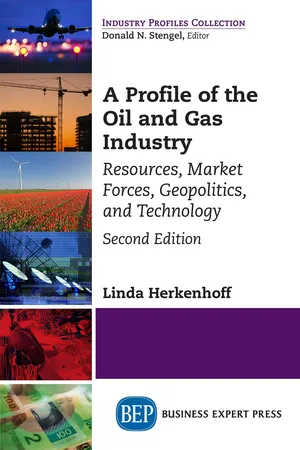![]()
CHAPTER 1
Introduction
There may be no other industry in the world that requires a more diverse set of competencies and skills: human, political, technical, mechanical, and financial. This is an industry that is intimately entangled with national strategies and global power. This chapter will provide an overview of the evolution of hydrocarbon demands and the industry that has subsequently developed to cope with those demands.
1.1 Early History
1.2 Seven Sisters
1.3 The Basics
1.1 Early History
This is an industry with a long and complex history, starting as far back as 4000 BC people used oil obtained from ground seeps to waterproof boats and to act as an adhesive in the construction of buildings. We know that crude oil was refined in minor quantities for lamp and heating oil in China around 1000 BC and in 600 AD, the Byzantines used crude oil to produce flame weapons. In North America, Seneca Indians used oil as a medicine for skin ailments.
From the 16th century through the 19th century, whales provided the primary source of oil. Whale oil was used principally as lamp fuel and in the production of soap. But as the scarcity of whales became a reality, the modern hydrocarbon energy was born. Samuel Kier is credited with being the first person in the United States to refine crude oil into lamp oil or kerosene, as a replacement for whale oil around 1861. Pennsylvania Rock Company, later called Seneca Oil, completed their first successful drilling for oil in 1855 at Oil Creek, Pennsylvania in the United States. International drilling operations were also becoming active in areas such as Bóbrka, Poland in 1854; Wietze, Germany in 1857; and Oil Springs, Ontario, Canada in 1858. This was the era when crude oil became affectionately known as “black gold” for obvious reasons.
This new industry in the United States was consolidated and monopolized by John D. Rockefeller. He formed the Standard Oil Company in 1870, and by 1890, his company had 90% of the U.S. oil market. In response to concern over this monopolistic position, the Sherman Antitrust Act (1890)1 was used in 1911 to split Standard Oil into 34 competing firms. This included the formation of Exxon, Chevron, Texaco, Mobil, Amoco, and Conoco.
While the antitrust movement was percolating, the first large U.S. oilfield was discovered by Gulf Oil in 1901 at Spindletop, Texas, producing over 50,000 barrels per day (Exhibit 1.1). It contributed 20% of the daily U.S. production at the time and led to a collapse in the price of oil.
Exhibit 1.1 Lucas Gusher at Spindletop Hill, 1901
Source: John Trost, Wikimedia Commons.
But outside the United States, other fields of this same magnitude were also being developed in countries such as Indonesia (1890s) and Persia (1908). In Azerbaijan in 1890s, the Nobel Brothers, John D. Rockefeller, and the Rothchilds fought for world oil dominance.
The history of crude oil started with lamp oil, but it was soon followed by its use as transportation fuel. Some of the market developments that pushed the expansion of this industry included the Wright Flyer’s need for fuel in 1903 and the Model T’s need for fuel in 1908. World War I certainly created market demand for oil as a fuel source for military ships. The advent of the centrifugal gas turbine for jet propulsion in 1930 also added market demand.
Petroleum gas oil was one of the early generic names given to automotive engine fuels by scientists. Everyday use meant the name quickly got shortened; in Europe, the British and Irish adopted the petroleum part of “petroleum gas-oil,” which later was shortened to just petrol, whereas in Canada and the United States, they adopted the gas oil part, initially naming the fuel gasoline because of its tendency to vaporize and easily become a gas.
1.2 Seven Sisters
In 1960, the Organization of Petroleum Exporting Countrie...

